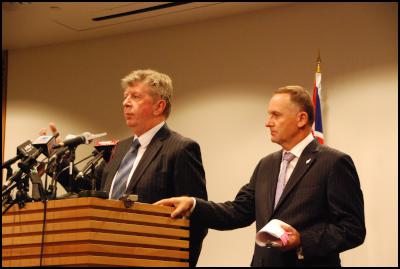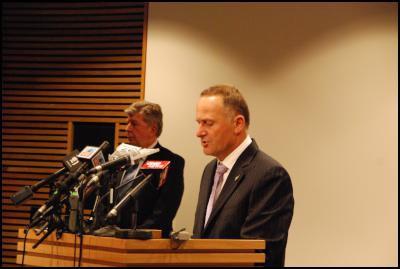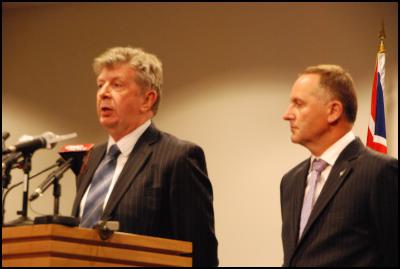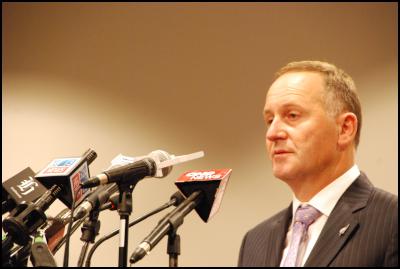Lessons Learned: PM on Earthquake Royal Commission Report
Scoop Audio+Video+Photos
By Mark P. Williams

Today the Prime Minister announced the release of third and final part of the Canterbury Earthquake Royal Commission Report. He was joined at his post-cabinet press conference by the Hon. Maurice Williamson, Minister for Building and Construction. The PM said that the report has wide-ranging implications for people across New Zealand. He said that the full report contains 189 recommendations in total.
The Prime Minister said that 175 of the 185 deaths in the 22 February earthquake were due to failures of buildings or parts of buildings. He said that the last parts of the report were released today without a government response so that those affected by the earthquake could read the report as soon as possible.
Regarding the collapse of the CTV building, he went on to say that volume six of the report provided a "robust analysis" of the specific failings of the CTV building in which 115 people lost their lives. The Prime Minister said that the CTV building should never have been issued with a building permit by the Christchurch City Council because it did not comply with the regulations of the time.
The Prime Minister emphasised that the forces of the Canterbury earthquake were unprecedented in scale, and exceed even what more buildings today are designed to withstand, saying that GNS had likened it to a once in 2,500 year seismic event. He added that, given the extreme nature of the earthquake, most buildings in Christchurch performed well in terms of preserving life.
The Prime Minister said that there are presently estimated to be between 15,000 and 25,000 earthquake prone buildings in New Zealand and the public must be given time to respond to the implications of the report. He said that it is important to realise that there is no such thing as an earthquake proof building but rather it is a question of mitigating risks.
The Prime Minister then handed over to Mr Williamson.
Hon. Maurice Williamson
Mr Williamson said that the
earthquake
Mr Williamson then spoke about the
implications for the Royal Commission's report on building
regulations. He emphasised that because of the highly
technical and specialised nature of the information required
to make an informed decision he could not yet say when he
would be able to make a final statement.
He said that
the main considerations of his department were:
- How far do we go?
- How fast do we go?
- What part do we mandate as opposed to allowing freedom of choice?
He took brief questions from the press gallery.
Questions to Mr Williamson
Mr Williamson was asked whether he expected any sort of legal challenges. He responded that he had asked specifically for legal advice about what could be done to hold those responsible to account, including addressing the matter through the police and courts. He did however say that most civil proceedings would be outside of the statute of limitations because of the time frame.
Mr Williamson was asked if that would include criminal charges. He re-emphasised that he was asking for advice on all possibilities.
Mr Williamson was asked whether there was any liability on the part of the Crown. He responded that the Crown was "not a player in any of this", and added that the whole matter of consenting and inspecting was a matter for Christchurch City Council.
Mr Williamson was asked how much tougher the new regulatory regime would have to be. He responded that many of the safety and regulatory changes had already been made since the construction of the CTV and PGC buildings and much of the problem was already in the process of being addressed before the earthquake struck.
Mr Williamson was asked what he was doing to reassure those who were working in buildings that they had concerns about. He responded that it was to do with a very particular "genre of buildings" which was considered to be at risk because of combinations of factors which included "asymmetric sheer walls", "non-ductile columns" and "unreinforced masonry". Mr Williamson was then asked how many buildings across the country were being considered. He responded that there were 379 buildings but stated again that the combination of the factors did not necessarily indicate that a particular building of the same "genre" as the CTV building was actually a risk. He said he would announce the result when a determination had been made on each building.
Mr Williamson was asked when the buildings around New Zealand which were thought to be at risk had been built. He responded that the "genre of buildings" in question had been narrowed down to the period 1985 to 1992 and emphasised that it was a question of a very specific combination of factors in those buildings which needed to be addressed, and his department had yet to received final reports on how many of the buildings estimated to fall within that "genre" and period of building would actually be considered a risk.
Mr Williamson was asked whether he felt it was right that the list of buildings not be released and whether it was a matter for public interest, particularly for people who may have to work in such buildings. He responded that because of the complexity of the factors involved it would be irresponsible to name all of the buildings within that genre and period when it had yet to be determined whether they were at risk or not.
Mr Williamson was asked why the statute of limitations applied to the legal questions over the construction of the buildings. He indicated that he believed that this was because the actions for building consents were considered the starting point but said that he was uncertain.
Questions to the Prime Minister
The PM was asked a series of linked questions on the matter of the GCSB and Kim Dotcom:
- When did the SIS Director know that the GCSB was had Kim Dotcom under surveillance?;
- When did the SIS director know this was illegal?
- Did the head of the SIS advise the PM's office of this?;
- And, if not why not?
He responded to the first parts of the question that he did not know and regarding whether the Director advised the PM's office, he replied that he did not.
The PM was asked about an immigration fraud case where the agent used a photograph of the PM on their website. He replied that it was only an issue if it was being used as an endorsement as lots of people use photographs of the PM and are free to do so as long as it is not employed as an endorsement as this would be counter to the rules of the Cabinet manual.
The PM was asked whether he was concerned about the levels of immigration fraud involving Chinese nationals. He responded that he was always concerned with fraud but that he had no specific advice on the matter.
The PM was asked about Chinese tourism numbers and the link being put forward between SkyCity and visa fast-tracking Chinese "high-rollers". He responded that SkyCity were not involved as he understood it.
The PM was asked about the case of Todd Rippon being sacked as a tour guide for his alleged comments on The Hobbit and his involvement in the Actor's Equity Union. He responded that it was an employment matter and he was not involved.
The PM was asked whether there was anything to the suggestion that he viewed the Actor's Equity Union as an opponent of Tourism New Zealand. He responded that he did not.
The PM was asked whether the issue of plain tobacco packaging had been raised at cabinet. He replied that there had been one small reference at Cabinet committee level.
The PM was asked why New Zealand was targeting Chinese tourists when the data indicated that Chinese tourists spend less money and time in New Zealand than other tourists. He responded that they constituted a very big market and that China as a nation is getting wealthier and so it is in New Zealand's interests to "grow that market".
The PM was asked whether he was worried about the agency and the approach it has taken given that a foreign journalist on Mr Rippon's tour has said that they do not wish to be named for fear of upsetting Tourism New Zealand. He responded that he was not concerned and emphasised that it was an employment matter.
The PM was asked whether cabinet had discussed how the Doha climate discussions would affect New Zealand and whether cabinet was concerned that New Zealand would lose access to carbon markets by refusing to sign up to Kyoto Two/CP2. He responded that the government was "very comfortable" with the position that they had taken and he believed that they were in "exactly the right space".
The PM was asked about the changes to vehicle Warrant of Fitness and whether the government had made a final decision. He responded that a final decision had not yet been made and that there were no other countries in the world which had six-monthly warrants of fitness.
The PM was asked about the Australian DJ prank and whether he had any concerns about New Zealand radio DJs. He responded that the news was very sad but that DJs had been doing similar pranks for decades and it was a question of them thinking through their actions.
The PM was asked if the government was doing enough to address child poverty. He responded that the report did show that the government was on the right track in having a strong economic focus, even though there was still work to be done.
The PM was asked whether he would give any consideration to Hone Harawira's Food In Schools Bill. He said that it was not necessarily a problem of widespread hunger in schools which needed to be addressed but a question of targeting more precisely rather than applying a "universal approach".
The PM was asked if he had got any further with "Waka-jumping" legislation to prevent list MPs staying on in Parliament if they no longer represented their original party. He said that he had not given it much thought as yet because it was a very difficult issue to legislate for. He was then asked about whether he would take Brendan Horan's proxy. He responded that he did not think so.
The PM was asked whether he used roaming data when he went abroad. He responded that it depended where he went and what he did.
Returning to the matter of the Doha climate talks, the PM was asked whether he was aware of the risks to New Zealand of not signing up to Kyoto Two/CP2. He responded that he remained comfortable with New Zealand's position.
Finally, the PM was asked whether he would be attending MegaChristmas in Auckland, the Christmas show which would be starring Kim Dotcom. He responded that he would not -- and then wished everyone a Merry Christmas since today was the last post-cabinet press conference of the year.
Click a link to play audio (or right-click to
download) in either
MP3 format or in OGG format.








 Peter Dunne: Luxon Gets Out His Butcher's Knife - Briefly
Peter Dunne: Luxon Gets Out His Butcher's Knife - Briefly Binoy Kampmark: Warring Against Encryption, Australia Is Coming For Your Communications
Binoy Kampmark: Warring Against Encryption, Australia Is Coming For Your Communications Gordon Campbell: On Fast Track Powers, Media Woes And The Tiktok Ban
Gordon Campbell: On Fast Track Powers, Media Woes And The Tiktok Ban Binoy Kampmark: Censorship Wars, Elon Musk, Safety Commissioners And Violent Content
Binoy Kampmark: Censorship Wars, Elon Musk, Safety Commissioners And Violent Content Gordon Campbell: On The Public Sector Carnage, And Misogyny As Terrorism
Gordon Campbell: On The Public Sector Carnage, And Misogyny As Terrorism Ramzy Baroud: NATO’s Never-ending War: The 75-Year-Old Bully Is Faltering
Ramzy Baroud: NATO’s Never-ending War: The 75-Year-Old Bully Is Faltering